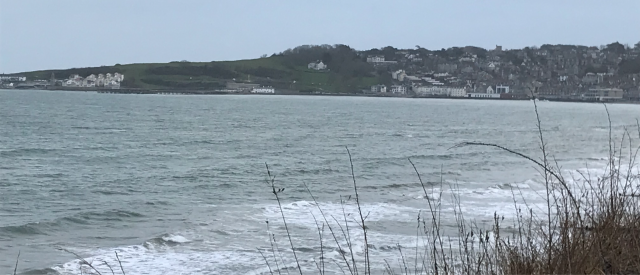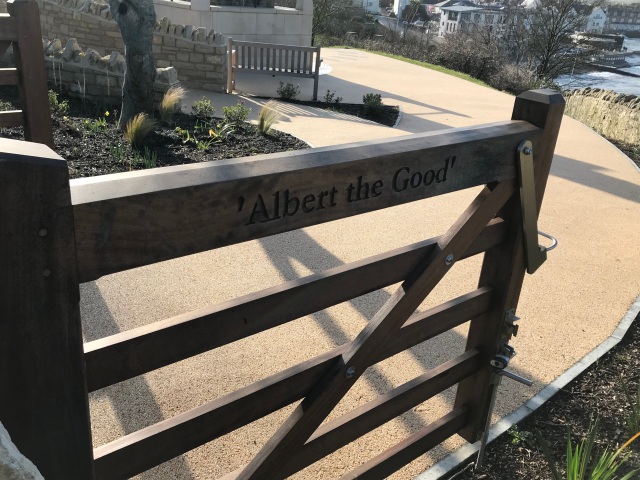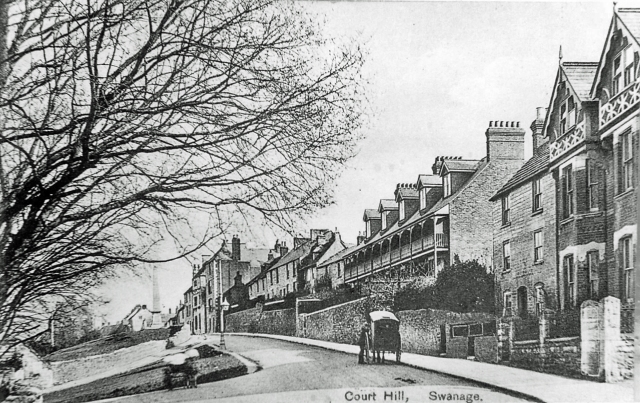Everyone knows about the grand memorial to Prince Albert in Kensington Gardens opposite the Royal Albert Hall, and on the edge of what was once called Albertopolis, but recently I went to see a less pretentious local memorial which was the first in the country to be put up to honour Albert the Good after he died in 1861.
The story of its original construction and then decline and dismantling is interesting but the story behind its recent re-construction is just as good and says a lot about local pride and the power of volunteers

The photos are mine unless otherwise acknowledged
I was in Swanage, a lovely Dorset seaside town that I’ve visited many times over the years and strolling along the seafront when I noticed something I’d not seen before. It stood in a commanding position, on a green stretch of hillside that rises at the southern end of the bay. Getting closer I saw it was an obelisk and nearby were two freestanding classical columns. Of course I remembered seeing the columns before – difficult to miss them – but I confess to not having ever noticed that this stretch of green was named Prince Albert Park. I thought it must have been a 19thc municipal park that, like many others, had fallen on hard times, lost all its ornate flower beds and garden features and been remodelled into a more easily maintainable bit of public open space. I was wrong about that as we’ll see. Had I forgotten the obelisk too? .

The southern end of the bay – from the far northern end. The obelisk and columns are just about visible
Swanage has a long history based originally on quarrying the local Purbeck marble and limestone but started to become a tourist destination in the early 19th century, when the local MP turned a mansion in the town into a luxury hotel. Its fame was helped when in 1833 it played host to Princess Victoria.
This spurred further development led by John Mowlem, who founded the famous building company, and his nephew George Burt. Ships that were sent to London loaded with Purbeck stone came back carrying ballast, and believe it or not this sometimes included salvaged bits of demolished buildings or even the occasional redundant monument. Several of these were re-erected or repurposed in the town including the front of the town hall.

Victori ana d Albert
The 20 year old Prince Albert had married Queen Victoria in 1840. Despite their obvious love for each other the situation was clearly not as easy as either of them had expected with Albert famously soon saying “I am very happy and contented; but the difficulty in filling my place with the proper dignity is that I am only the husband, not the master of the house.” There was great concern in the years after his marriage that as a foreigner he should not play any role in government. Nevertheless once they started having children he stepped in to help Victoria with the administration of what was to become be an informal dual monarchy.
Prime Minister Robert Peel encouraged Albert to take on “non-political” public roles independently of the queen. First he became head of a royal commission appointed in October 1841, to promote and encourage the fine arts in the United Kingdom. This led to him becoming president of the Society of Arts in 1843 and then taking the the lead in organising the Great Exhibition. When that opened in 1851 he was still only 32. It was at his insistence that the considerable profits were used to establish a permanent legacy: the educational, cultural, and scientific institutions including of course the V&A in South Kensington, sometimes known as Albertopolis. The fund he established is still running. Amongst other things he also modernised the royal household, set up a model dairy farm at Windsor and oversaw the building of Osborne.
Albert was also passionately concerned with promoting social justice, raising public consciousness about “the evil” of child labour and lack of proper education for half the nation’s children. He also campaigned for better housing for the working classes, and this included having model cottages designed for the Great Exhibition. These good causes resonated with many of the public.
His early death in 1861 aged only 42 led Disraeli to note that ‘with Prince Albert we have buried our Sovereign. This German Prince has governed England for twenty-one years with a wisdom and energy such as none of our kings has ever shown‘.
Although Albert never fully adapted to English society and culture, there is no doubt he was genuinely mourned by many because of his compassion and tireless concern to improve the lives of ordinary people. There was an outpouring of public grief, a mid-19thc although less strident equivalent of what happened after Princess Diana died. It led to a cult of memorialising Albert headed by Victoria herself.
The result was that Albert has more major monuments than any other non-monarch. The best known are in London: the Albert Memorial in Hyde Park and the Royal Albert Hall, both completed in 1872. But there are plenty of others
There are public parks named in his honour in Abingdon, Middlesborough, and Salford. There are Albert Clocks in Barnstaple and Belfast, the Royal Abert Museum in Exeter, and statues everywhere from Aberdeen to Wolverhampton via Liverpool Edinburgh and Tenby. And of course there are Albert Squares – including the one on East Enders – as well as Albert Roads, Streets and Avenues all over the place.
Swanage was no different. Albert and his eldest son, the future Edward VII, had visited the town briefly in 1856 and George Burt, on hearing of the prince’s death decided that the town should honour his memory.
He wrote to the Rev Duncan Travers, the Rector, suggesting Swanage ‘should erect an obelisk of native stone with a short but suitable inscription… and that the inhabitants generally should subscribe money to pay for its erection… My motive in writing you on this subject is merely to bring it fairly before the inhabitants, believing that it would not only be a guide to rising generations in the path to virtue, duty, and honour, but that it would be most pleasing to Her Most Gracious Majesty the Queen, and His Royal Highness the Prince of Wales, to hear of such an act by the inhabitants of Swanage, especially as they have both a kindly recollection of their visits to this place.’
Burt’s proposed obelisk was to be in the same style as one he knew in London, which honoured Robert Waithman, a former Lord Mayor of London, and which is still standing in Salisbury Court off the Strand. His uncle John Mowlem gave a plot of ground and the money for building the monument was met by public subscription, with an undertaking by the parish authorities that they would pay for any on-going maintenance. Burt gave the railings and the parish laid the surrounding paving. The inscriptions were cut for free by local masons John and James Haysom although they made a mistake and gave Albert the wrong birthday!

Why an obelisk? Perhaps because it could be erected much more quickly and much more cheaply than putting up a statue. It took until 1865 for the first of those to go up in Albert Square in Manchester.
Burt’s obelisk stood for about 30 years before there was a great blizzard in 1881 which was so fierce that it damaged the top two courses of stone by twisting them out of alignment.
More damage was caused another storm in 1901 although it must have been repaired because a postcard of 1910 shows it intact. However another photo from 1931 shows it had been truncated, and without the top 13 courses of stone.
Locals think this might have been at the request of the owner of the neighbouring property concerned that it would cause serious damage if it fell. This dismantling was probably done by a local builder who stored the stones in his yard for about 15 years before, presumably despairing of repairs being undertaken by the authorities, deciding to sell them. Eventually the stones ended up in a yard at nearby village of Langton Matravers where they were safe but largely forgotten.
At this point resourceful volunteers begin to step in. As the centenary of Albert’s death grew closer local historian, David Lewer began a campaign to get the obelisk repaired.
Unfortunately he failed and the owner of site of the remaining stump later applied for permission to redevelop the site for housing. When this was eventually granted it was on condition that the monument was re-erected by the developer at his own expense on another site. Despite several possibilities being discussed, nothing was agreed and the developer simply took the stump down and put the stones into storage.
Even then this action was controversial, and according to Bob Field of the local museum working group which has researched the obelisk’s history . ‘When the day came Susan Haysom, whose husband was the great grandson of the John Haysom that carved the inscription, sat on top of the stone for forty-five minutes until the police talked her down.’
The next attempt to rebuild the obelisk was to mark the Queen’s Silver Jubilee in 1977. That too failed.
However yet another chance arose about 20 years later.

Swanage from the site of the miniature gold course. Postcard from the 1960s? 70s?
 What I first remembered being on the slopes at the southern end of the bay was a miniature golf course. When it closed the site was earmarked for a public park as part of the Swanage Seafront Improvement Scheme. Because it overlooked the place where Albert had landed in 1856 it was decided to name the new park in his honour. But the campaign to get the obelisk installed there also failed. Instead the main feature of the design was the installation of two early 19thc Portland stone columns, around which were built a small amphitheatre. These columns, which are now listed were formerly part of the nearby but then recently demolished Grosvenor Hotel.
What I first remembered being on the slopes at the southern end of the bay was a miniature golf course. When it closed the site was earmarked for a public park as part of the Swanage Seafront Improvement Scheme. Because it overlooked the place where Albert had landed in 1856 it was decided to name the new park in his honour. But the campaign to get the obelisk installed there also failed. Instead the main feature of the design was the installation of two early 19thc Portland stone columns, around which were built a small amphitheatre. These columns, which are now listed were formerly part of the nearby but then recently demolished Grosvenor Hotel. 
The new Gardens won a Civic Trust award in 1997 for their use of local materials and attention to detail, so my first thoughts about the park being a Victorian creation which had fallen on hard times were completely wrong. Just shows one shouldn’t judge things by their name alone.
After the failure to get the obelisk included in that scheme yet another attempt was made to have it rebuilt for the Millennium. That too failed. It’s a good thing volunteers are persistent because they had another go in 2019 this time to celebrate the 200th birthdays of both Albert and Queen Victoria. I suspect to lots of local surprise, this time the idea began to gain acceptance.

Swanage Town Council declared itself in favour of the idea in theory, but declined to fund the £11,000 estimated to repair and replace the missing stones and the additional £20,000+ to rebuild the monument in Prince Albert Gardens, although they did offer some staff time to support the volunteer working party. “Members were very supportive of the idea in principle, but the Town Council has recognised that restoring and re-siting a Victorian monument to meet 21st century requirements poses significant challenges: health and safety legislation, the planning framework and ways of fundraising are all very different to when the monument was first erected in the 1860s.”
 They were also doubtful about the site, citing their Civic Trust award as a reason for not including the obelisk as it “may be seen as incompatible with that award-winning design.” They suggested other locations, none quite so prominent and as the volunteers pointed out none quite as appropriate as Prince Albert Park. In the end planning permission was granted in 2020 for the obelisk to be re-erected high on the edge of the park, well away from the amphitheatre. The Museum team set out to raise the money but were very fortunate that a generous private benefactor came forward and agreed to foot the bill.
They were also doubtful about the site, citing their Civic Trust award as a reason for not including the obelisk as it “may be seen as incompatible with that award-winning design.” They suggested other locations, none quite so prominent and as the volunteers pointed out none quite as appropriate as Prince Albert Park. In the end planning permission was granted in 2020 for the obelisk to be re-erected high on the edge of the park, well away from the amphitheatre. The Museum team set out to raise the money but were very fortunate that a generous private benefactor came forward and agreed to foot the bill.
The formal “unveiling” of the restored obelisk, with its surrounding hard landscaping and benches was last autumn. 
 The Prince Albert Park is the last surviving bit of green along the Swanage seafront and it forms a gradual transition from the urban edge of the town to the wilder adjoining landscape of the Downs and the coastal path. Its clearly much loved and well-used and has a big part to play in the summer months when the amphitheatre is the site of concerts and other entertainments.
The Prince Albert Park is the last surviving bit of green along the Swanage seafront and it forms a gradual transition from the urban edge of the town to the wilder adjoining landscape of the Downs and the coastal path. Its clearly much loved and well-used and has a big part to play in the summer months when the amphitheatre is the site of concerts and other entertainments.
To be honest its not wildly exciting as a garden, but there are plenty of daffodils and some basic planting along one edge around the Lady of the Rocks, a Purbeck stone sculpture by Mary Spencer Watson. However it does enjoys beautiful views of Swanage Bay and the Isle of Wight in the distance. And what more could you want on a nice sunny day than to sit and look at such an amazing view, watch the boats, the changing weather and, of course, contemplate the life and works of Albert the Good.

For more information about Prince Albert, I’d recommend A.N.Wilson’s The Man who saved the Monarchy [2019] , and the website of the 1851 Commissioners, and the on-line section about Albert on the Royal Collections Trust website.
For the Albert Memorial in Swanage try the museum website and these articles in Dorset Life and Swanage News,
You might also be interested to know that in 1883George Burt built another obelisk for a completely different reason which stands on Ballard Down which rises above the opposite end of the town.



















You must be logged in to post a comment.